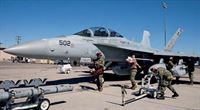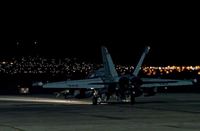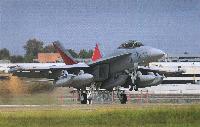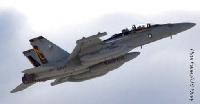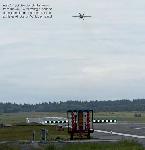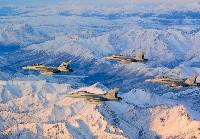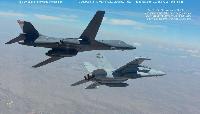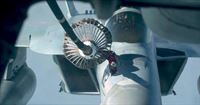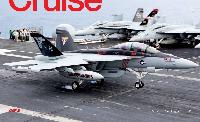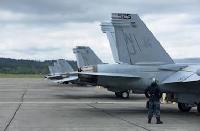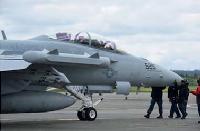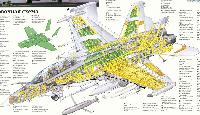
Варианты
- Northrop - YF-17 Cobra - 1974 - США
- McDonnell Douglas - F/A-18A Hornet - 1978 - США
- McDonnell Douglas - F/A-18B Hornet - 1979 - США
- McDonnell Douglas - F/A-18C Hornet - 1986 - США
- McDonnell Douglas - F/A-18D Hornet - 1987 - США
- McDonnell Douglas - F/A-18E Super Hornet - 1995 - США
- McDonnell Douglas - F/A-18F Super Hornet - 1995 - США
- Boeing - EA-18G Growler - 2006 - США
Boeing F/A-18 Super Hornet и EA-18 Growler
<...>
Кроме того, вариант РЭБ F/A-18F, способный как создавать активные помехи, так и уничтожать ПВО противника, превратился в EA-18G Growler. Достигший начального уровня боеготовности в сентябре 2009 года, опытный образец Growler совершил первый полет в 2001 году. Самолет объединяет цифровую станцию РЭП ALQ-218C подвесной системой ALQ-99 самолета EA-6B Prowler. Эти системы позволяют подавлять многие передатчики, точно определенные и идентифицированные. EA-18G также оборудован мощной РЛС APG-79, которую в ВМС США планируют использовать для прямой атаки на передатчики противника. Полагают, что сфокусированный направленный луч энергии от антенны AESA мог бы вывести из строя излучающую антенну. Growler способен использовать собственные системы связи и передачи данных в процессе постановки помех с помощью системы подавления помех (Interference Cancellation System), что недоступно экипажам Prowler. Система постановки помех нового поколения должна вступить в действие с 2018 года как замена ALQ-99.
<...>
- Описание
Фотографии
-
Air International 2006-09 / News: Headline, Military, Civil, Airshow
Большая часть уникального электронного оборудования AEA установлена в отсеке, где у F/A-18F размещалась авиапушка, и в двух обтекателях на концах крыла. Оставшиеся девять подвесок предоставляют уникальную возможность для размещения на них различных видов боеприпасов, электронного и другого оборудования.
A ceremony at Boeing's Integrated Defense Systems facility in St Louis, Missouri, on August 3, 2006 saw the formal unveiling of the first EA-18G Growler electronic attack aircraft, Bu No 166641, in front of a crowd of more than 750 US Navy customers, industry partners and Boeing employees. Rather surprisingly for a prototype aircraft, the Growler was already painted in the markings of one of the current EA-6B Prowler units that will receive the type, VAQ-129 'Vikings' at NAS Whidbey Island, Washington. First flight was due to take place later in the month, several weeks ahead of the originally scheduled date. Flight testing will then be undertaken at the Navy's facilities at China Lake, California, and Patuxent River, Maryland, through to 2008, following which the Growler will enter fleet service and achieve Initial Operational Capability with the US Navy in 2009. -
Air International 2008-07 / News: Headline, Military, Civil, Airshow, Accidents
Boeing officially handed over the first EA-18G Growler to the US Navy at NAS Whidbey Island, Washington, during a ceremony held there on June 3, 2008.
-
Air International 2011-12 / News
Air Test and Evaluation Squadron 23 (VX-23) 'Salty Dogs' concluded testing of the EA-18G Growler H8E Software Configuration Set in November with Salty Dog 521, NEA-18G Growler BuNo 166899/‘SD521’. The new software build provides cockpit improvements including jammer footprints, air-to-ground multi-source integration, CCS manual threshold (THOLD), emitter power levels, AARGM interface, off board jammer requests and automatic parametrics through Link 16. Operational testing of the H8E software is expected to start with VX-9 'Vampires' at NAWS China Lake in early 2012.
-
Air International 2013-04 / Growler
VAQ-129 ‘Vikings’ is the EA-18G Growler Fleet Replacement Squadron based at NAS Whidbey Island.
-
Air International 2013-04 / Growler
A pair of VAQ-132 EA-18Gs line up for take-off from NAS Whidbey Island on a routine training flight over the Okanagan Mountains in eastern Washington state.
-
Air International 2013-04 / Growler
The Growler’s nose wheel steering enables the aircraft to be easily manoeuvred around a carrier flight deck.
-
Air International 2008-04 / D.Hobbs - Super Hornet - Versatile strike fighter /Military/
EA-18G создан на базе двухместного F/A-18F. На самолете установлены новые антенны и обтекатели на законцовках крыла.
The US Navy intends to purchase 87 EA-18G Growlers to replace its electronic attack Prowlers. This EA-18G is pictured making the first visit by the type to NAS Whidbey Island, home of the US Navy's electronic attack squadrons, on April 9, 2007. -
Air International 2020-04 / M.Ayton - EA-18G Growler. 21st Century Electronic Attack
The first publicly released image of an EA-18G Growler assigned to VX-23 loaded with a ALQ-249 Next Gen Jammer pod on station 3 (middle).
-
Air International 2019-12 / M.Ayton - Red Flag's big shift /Military/
The US Navy regularly deploys EA-18G Growler aircraft to Red Flag to provide its highly specialised electronic attack capability in the exercise scenarios.
-
Air International 2015-11 / Pax: Home of US Navy flight testing
VX-23's NEA-18G Growler BuNo 166641/SD521 loaded with three ALQ-99 tactical jamming pods.
-
Air International 2017-08 / M.Ayton - Jamming or Deception /Military/ (1)
This shot of Viking 521 shows the configuration of antennas and blisters fitted to the aircraft, and the close proximity of the centerline fuel tank to the nose wheel landing gear
-
Air International 2012-07 / News
The Airborne Electronic Attack Weapons School (AEAWS) of the Naval Strike and Air Warfare Center currently has two Boeing EA-18G Growler airborne electronic attack aircraft in service at NAS Fallon, Nevada. They are BuNos 168274/'501' (seen here) and 168273/'500'. The AEAWS was established in November 2011 to provide electronic attack squadrons with techniques, tactics and procedures to employ the aircraft.
-
Air International 2017-08 / M.Ayton - Jamming or Deception /Military/ (1)
A student pilot taxies Viking 554 from the VAQ-129 with wings folded in accordance with standard training procedures.
-
Air International 2017-09 / M.Ayton - Jamming or Deception /Military/ (2)
Electronic Attack Squadron 134 (VAQ-134) ‘Garudas’ is one of four EA-18G expeditionary squadrons which are not assigned to a carrier air wing. All four units deploy to forward operating bases in support of, but not exclusively, the US Ar Force. The squadron’s CAG-bird, EA-18G BuNo 168765/ NL530, features a four-colour tail flash and red titles.
-
Air International 2019-12 / M.Ayton - Red Flag's big shift /Military/
An EA-18G Growler assigned to Electronic Attack Squadron 135 (VAQ-135) heads to the runway on a night time Red Flag mission.
-
Air International 2017-08 / M.Ayton - Jamming or Deception /Military/ (1)
Combat payloads carried by the EA-18G Growler vary, and require the combined 44,000lb (196kN) of thrust to get airborne. Viking 521 is seen launching with full afterburner in a clean training configuration giving the pilot an easy take-off performance.
-
Air International 2013-04 / Growler
The Growler’s two General Electric F414-GE-400 turbofan engines generate a combined 44,000 lbs of thrust with afterburner.
-
Air International 2013-04 / Growler
Some local training flights flown by the EA-18Gs from NAS Whidbey Island do not require ALQ-99 jamming pods to be carried.
-
Мировая Авиация 101
Подготовка экипажей Growler возложена на 129-ю эскадрилью РЭБ "Vikings" (VAQ-129), дислоцированную на авиабазе ВМС США Уидби-Айленд.
-
Air International 2006-10 / News: Headline, Military, Civil, Accidents
Boeing's first EA-18G Growler development aircraft, 166614 (EA-1), lifts off the runway at Lambert International Airport, St Louis, Missouri, on August 15, 2006, at the beginning of its maiden flight. First flight took place only two weeks after the aircraft had been officially rolled out.
-
Air International 2013-04 / Growler
VAQ-135 'Black Ravens' participated in exercise Red Flag 13-3 at Nellis AFB in early March 2013. Red Flag 13-3 was the first large force exercise undertaken by VAQ-135 since it returned from deployment to Bagram AB, Afghanistan.
-
Авиация и Время 2006-05
Самым современным самолетом семейства Hornet является EA-18G Growler, специально предназначенный для ведения радиоэлектронной войны. Он представляет собой версию двухместного Block II F/A-18F Super Hornet. Самолет должен поступить на вооружение в 2009 году и заменить устаревший Grumman EA-6B Prowler.
-
Air International 2013-04 / Growler
As part of the squadron’s work-up for deployment to Iraq in November 2010, VAQ-132 participated in exercise Red Flag 10-4 at Nellis AFB, Nevada.
-
Air International 2017-08 / M.Ayton - Jamming or Deception /Military/ (1)
An EA-18G Growler climbs away from runway 14 following a bounce during field landing carrier practice at Naval Air Station Whidbey Island.
-
Air International 2013-04 / Growler
EA-18G Growler BuNo 166642/'DD500' of Air Test and Evaluation Squadron 31 'Dust Devils', carried an AGM-88E AARGM missile for the first captive-carry flight test on May 25, 2011.
-
Air International 2017-08 / M.Ayton - Jamming or Deception /Military/ (1)
A view of an EA-18G Growler captured through night vision goggles.
-
Air International 2015-05 / M.Ayton - Dust, Devils & Development /Military/
EA-18G BuNo 168377/’DD523' carries a standard Growler payload comprising an external fuel tank and an ALQ-99 pod under each wing. The upper part of each pylon is marked with an orange patch denoting a test fitting.
-
Air International 2008-02 / R.Burgess - Jamming to Save Lives in Iraq and Afghanistan /Military/
Этот выполняющий испытательный полет EA-18G оснащен новейшим электронным оборудованием АЕА для ведения радиоразведки, подавления средств радиосвязи и радиолокации противника.
Boeing EA-18G Growler 166855 'NJ-551', the first production aircraft, which already carries the markings of VAQ-129, was handed over to the US Navy on September 24, 2007.
US Navy Prowlers are to be replaced by the electronic attack version of the Super Hornet - the EA-18G Growler. The new type uses electronic warfare systems based on the ICAP III version of the EA-6B and will start to be assigned to fleet VAQ squadrons from 2009. -
Air International 2015-05 / M.Ayton - Dust, Devils & Development /Military/
Испытания Growler продолжаются и в 2010 году, на фотографии - самолет 31-й опытной эскадрильи, дислоцированной на авиабазе Чайна-Лейк. Первой в октябре 2009 года состояния эксплуатационной готовности достигла 132-я эскадрилья РЭБ "Scorpions".
An EA-18G Growler assigned to VX-31 returns to Naval Air Weapons Station China Lake over the city of Ridgecrest, California. -
Air International 2021-08 / R.Thomas - Decision time
Should Finland opt for the Super Hornet, it would also become only the second country outside of the US to operate the EA-18G electronic warfare variant
-
Air International 2016-04 / News
Electronic Attack Squadron 142 (VAQ-142) ‘Gray Wolves' is currently assigned to Carrier Air Wing 11 (CVW-11) and operates the EA-18G Growler. The squadron’s latest CAG-bird BuNo 168381/NH500 features a white and blue livery, and colour badges of the squadron and CVW-11.
-
Air International 2017-09 / M.Ayton - Jamming or Deception /Military/ (2)
Electronic Attack Squadron 142 (VAQ-142) ‘Grey Wolves’ has its CAG-bird, EA-18G BuNo 168381/NH500, painted with dark blue vertical stabilisers. The squadron is one of ten Growler units assigned to a carrier air wing.
-
Air International 2015-05 / M.Ayton - Dust, Devils & Development /Military/
VX-31's EA-18G Growler project office is completing tests of the SCS H10, starting the follow-on H12 and supporting the Royal Australian Air Force as it prepares to receive the aircraft.
-
Air International 2013-06 / News
Winner: the Department of the Navy's budget request included procurement of 21 EA-18G Growler electronic attack aircraft and the establishment of two more expeditionary electronic attack (VAQ) squadrons.
-
Air International 2012-08 / News
Air Test and Evaluation Squadron 31 (VX-31) 'Dust Devils' based at NAWC China Lake, California, conducted flight testing of a satellite communications (SATCOM) system on an EA-18G Growler between May 23 and 30, 2012. VX-31 aircrew conducted satellite-enabled secure voice and data transmissions with ground-based teams at China Lake and at NAS Patuxent River, Maryland.
-
Air International 2019-04 / Airscene
Finland has received US government approval to purchase the Boeing EA-18G Growler, together with the F/A-18 Super Hornet if selected for its HX Fighter Replacement programme.
-
Air International 2020-04 / M.Ayton - EA-18G Growler. 21st Century Electronic Attack
VX-31 'Dust Devils' at NAWS China Lake, California, undertakes much of the Growler development work in partnership with VX-23 at NAS Patuxent River, Maryland.
-
Air International 2020-04 / M.Ayton - EA-18G Growler. 21st Century Electronic Attack
An NEA-18G Growler - BuNo 166642 ’DD-500’ (c/n F135/EA-2) - during a sortie.
-
Air International 2013-04 / Growler
The first system design and development EA-18G Growler aircraft, EA1, arrived at NAS Patuxent River, Maryland on September 22, 2006, a month prior to its scheduled delivery date.
-
Air International 2013-01 / The Aviation World in 2013
EA-18G с окрашенными в белый цвет килями и стилизованной эмблемой 9-й опытной эскадрильи "Vampires" несет на внешней подвеске контейнер с разведаппаратурой ALQ-218, две УР AGM-88 HARM, три контейнера РЭБ ALQ-99 и два ПТБ.
-
Air International 2013-04 / Growler
EA-18G Growlers assigned to the Black Ravens over Alaska en route to Eielson AFB for exercise Red Flag Alaska.
-
Air International 2013-04 / Growler
EA-18G Growlers assigned to the Black Ravens over Alaska en route to Eielson AFB for exercise Red Flag Alaska.
-
Air International 2023-01 / P.Roegies, B.Gorski, J.van Toor - Garudas Growling
The Garudas Growlers usually operate in pairs. While on station the aircraft were refuelled by the 92nd Air Refuelling Wing KC-135R Stratotanker aircraft
-
Air International 2020-04 / M.Ayton - EA-18G Growler. 21st Century Electronic Attack
A pair of Boeing EA-18G Growlers, BuNo's 168377 'SD-523' (c/n G63) and 169143 SD-527' (c/n G134), assigned to the US Navy's Air Test and Evaluation Squadron 23 (VX-23) fly in formation over the Atlantic Ocean in August 2018.
EA-18G Growlers assigned to VX-23 'Salty Dogs,' which undertakes a lot of handling stores integration work. -
Air International 2015-08 / N.Pittaway - Introducing Growler /Military/
Другие самолёты на фотографии: McDonnell Douglas F/A-18A Hornet - США - 1978
-
Air International 2017-08 / M.Ayton - Jamming or Deception /Military/ (1)
An EA-18G Growler and a B-1B Lancer assigned to the 28th Bomb Wing during a VAQ-129 Det at Ellsworth Air Force Base, South Dakota.
Другие самолёты на фотографии: Rockwell B-1B Lancer - США - 1983
-
Air International 2023-01 / T.Fish - Keeping up the pace
EA-18G Growlers from No 6 Squadron and F/A-18F Super Hornets from No 1 Squadron flying with a C-17A Globemaster III from No 36 Squadron off the coast of Queensland
Другие самолёты на фотографии: McDonnell Douglas C-17A Globemaster III - США - 1991McDonnell Douglas F/A-18F Super Hornet - США - 1995
-
Авиация и Космонавтика 2020-11 / С.Мороз - Противник номер один (19)
Целью модернизации комплекса связи B-52H в XXI веке является его глобальное применение в разнородных авиационных группировках
Exercise Cope North Guam 2014 was held between February 14 and 28, 2014. It was a multilateral training exercise conducted from Andersen AFB, Guam, and involved around 80 aircraft from the Japan Air Self Defense Force (JASDF), Royal Australian Air Force (RAAF) and US Air Force and Navy. Air-to-air training was conducted involving dissimilar air combat scenarios, air-to-ground sorties and simulated humanitarian assistance and disaster relief operations. This formation of participants comprises an EA-18G Growler of VAG-132 (tailcode ‘NL’), F-16C Fighting Falcon from the 35th Fighter Wing (‘WW), an 18th Wing F-15D Eagle (ZZ), a B-52H Stratofortress from the 20th Bomb Squadron ('LA'), JASDF F-15J (22-0929 of 204 Hikotai) and Mitsubishi F-2A, an RAAF No. 75 Squadron F/A-18A Hornet and an F-16C of the 364th Fighter Wing (‘AK').Другие самолёты на фотографии: Boeing B-52H Stratofortress - США - 1960General Dynamics F-16A/C/E Fighting Falcon - США - 1974McDonnell Douglas F/A-18A Hornet - США - 1978McDonnell Douglas F-15A/C Eagle - США - 1972McDonnell Douglas F-15B/D Eagle - США - 1972Mitsubishi FS-X / F-2 - Япония - 1995
-
Air International 2013-04 / Growler
The Next Gen Jammer pod should commence flight operations on the EA-18G Growler in 2015.
-
Air International 2019-10 / M.Ayton - Anti-access, area denial and artifical intelligence /Military/
An EA-18G Growler uploads fuel from the drogue of a KC-10A Extender.
Другие самолёты на фотографии: McDonnell Douglas KC-10 Extender - США - 1981
-
Air International 2013-04 / Growler
VAQ-132’s CAG-bird Growler BuNo 166894/’NL540' refuels from a US Air Force KC-135R Stratotanker. The squadron’s EA-18Gs undertook multiple air-refuellings and received up to 50,000 lbs of fuel during some of the missions flown over Libya while operating from Aviano AB in northern Italy.
Другие самолёты на фотографии: Boeing KC-135 Stratotanker / C-135 Stratolifter - США - 1956
-
Air International 2017-08 / M.Ayton - Jamming or Deception /Military/ (1)
An EA-18G Growler receives fuel from a KC-135 Stratotanker during a training sortie from Naval Air Station Whidbey Island.
Другие самолёты на фотографии: Boeing KC-135 Stratotanker / C-135 Stratolifter - США - 1956
-
Air International 2023-01 / P.Roegies, B.Gorski, J.van Toor - Garudas Growling
VAQ-134 was deployed to Spangdahlem Air Force Base at short notice and were supported by the 52nd Operational Support Squadron
-
Air International 2018-01 / D.Isby - US combat air power today and beyond /Military/
An EA-18G Growler from Electronic Attack Squadron 132 (VAQ-132) 'Scorpions’ air refuelling with a Royal Australian Air Force KC-30A tanker during Exercise Talisman Saber 2017.
Другие самолёты на фотографии: Airbus A330 MRTT / KC-30 Voyager - International - 2007
-
Air International 2020-04 / M.Ayton - EA-18G Growler. 21st Century Electronic Attack
An EA-18G Growler from VAQ-132 'Scorpions' takes on fuel from a Royal Australian Air Force KC-30A Multi Role Tanker Transport, an as F/A-18E holds alongside.
Другие самолёты на фотографии: Airbus A330 MRTT / KC-30 Voyager - International - 2007McDonnell Douglas F/A-18E Super Hornet - США - 1995
-
Air International 2011-05 / ??? - Operation Unified Protector /Africa/
A US Navy EA-18G Growler of Electronic Attack Squadron 132 (VAQ-132) 'Scorpions' refuels from a CC-150 Polaris. Six EA-18Gs re-deployed from Al Asad AB, Iraq to Aviano AB, Italy in support of Operation Odyssey Dawn.
Другие самолёты на фотографии: Airbus A310 - International - 1982
-
Air International 2022-05 / T.Fish - Staying grounded
An EA-18G Growler flies above the aircraft carrier USS Ronald Reagan during operations in the Arabian Sea in August 2021. Growler will be fitted with the AGM-88G Anti-Radiation Guided Missile Extended Range (AARGM-ER) weapon and manufacturer Northrop Grumman secured a second Low-Rate Initial Production contract in February 2022
-
Air International 2012-03 / News
Electronic Attack Squadron 141 'Shadowhawks', an EA-18G squadron based at NAS Whidbey Island, Washington will move to NAF Atsugi, Japan and join Carrier Air Wing 5. In April 2011, VAQ-141 was the first EA-18G squadron to deploy at sea, embarking as part of CVWS aboard the USS George H.W. Bush.
-
Air International 2013-04 / Growler
The EA-18G Growler needs to overcome threat systems with highly lethal SAMs, and prove highly adaptive in combat conditions.
-
Air International 2017-08 / M.Ayton - Jamming or Deception /Military/ (1)
EA-18G Growler BuNo 169137/NJ525 a second from touch down during a bounce.
-
Air International 2017-08 / M.Ayton - Jamming or Deception /Military/ (1)
Smoke spools from the tires as EA-18G BuNo 169137/NJ525 bounces on runway 14 during field landing carrier practice at Naval Air Station Whidbey Island.
-
Air International 2013-04 / Growler
VAQ-132's CAG-bird Growler BuNo 166894/'NL540' received desert tail markings, side numbers and insignia for the squadron’s 2010-2011 deployment to Iraq and Italy.
-
Air International 2016-07 / Airscene
EA-18G Growler BuNo 168772/AJ500 of Electronic Attack Squadron 131 (VAQ-131) ‘Lancers’ based at Naval Air Station Whidbey Island, Washington seen at Naval Air Station Fallon, Nevada in mid-May 2016. The aircraft deployed to Fallon for the latest Carrier Air Wing 8 work-up in this two-tone grey CAG-bird colour scheme.
-
Air International 2016-03 / News
Electronic Attack Squadron 130 (VAQ-130) ‘Zappers’ is currently assigned to Carrier Air Wing 3 (CVWS) and operates the EA-18G Growler. The squadron deployed its latest CAG-bird BuNo 168268/AC500 to Naval Air Station Fallon, Nevada during the air wing’s recent detachment to the desert base.
-
Air International 2017-08 / M.Ayton - Jamming or Deception /Military/ (1)
VAQ-129 typically flies its aircraft in a clean configuration during most phases of the course as shown by Viking 525.
-
Air International 2012-12 / N.Pittaway - Growlers Down Under /Military/
A US Navy EA-18G Growler touches down at RAAF Base Amberley for Exercise Growler 2012.
-
Air International 2017-09 / M.Ayton - Jamming or Deception /Military/ (2)
EA-18G BuNo 168256/NA500 is the current CAG-bird with Electronic Attack Squadron 139 (VAQ-139) 'Cougars'.
-
Air International 2017-09 / M.Ayton - Jamming or Deception /Military/ (2)
Forward deployed to Naval Ar Facility Atsugi, Japan, Electronic Attack Squadron 141 (VAQ-141) ‘Shadowhawks’ was originally assigned to Carrier Air Wing 8 (CVW-8) and made its maiden deployment on the USS George H W Bush. Today the unit is assigned to CVW-5.
-
Air International 2013-04 / Growler
VAQ-132 Growlers deployed to NAWS China Lake in March 2010 to utilise the threat emitters located on the extensive electronic range.
-
Air International 2017-04 / Airscene
To complete a quartet of CVW-11 aircraft in this section, EA-18G BuNo 168381/NH500 is the first Growler CAG-bird operated by Electronic Attack Squadron 142 (VAQ-142) ‘Gray Wolves’ which transitioned to the type during 2015 and continued work-up training throughout 2016. The squadron is set to make its first Growler deployment on board the USS Nimitz (CVN 68) during 2017.
-
Air International 2017-09 / M.Ayton - Jamming or Deception /Military/ (2)
EA-18G Growler BuNo 166934/NL540 is the CAG-bird of expeditionary squadron, VAQ-132 'Scorpions’ seen landing at Nellis Air Force Base, Nevada.
-
Air International 2013-04 / Growler
VAQ-132 EA-18G BuNo 166894/’NL540’ lands at Aviano AB, Italy following a mission to Libya during Operation Unified Protector. The aircraft is loaded with two AGM-88 HARM missiles, two AIM-120 AMRAAM air-to-air missiles and two ALQ-99 jamming pods.
-
Air International 2017-09 / M.Ayton - Jamming or Deception /Military/ (2)
VAQ-131 'Lancers’ recently returned from deployment aboard the USS George H W Bush (CVN 77). The squadron operates a two-tone grey CAG-bird, EA-18G BuNo 168772/ AJ500, which appears to be coated in Have Glass paint; a coating designed to reduce the infrared signature of the jet.
-
Air International 2012-04 / News
Growler из 129-й эскадрильи РЭБ "Vikings" проходит над кормовым срезом палубы авианосца "Рональд Рейган". Снимок сделан в феврале 2008 года во время испытаний "на совместимость" самолета и авианосца.
An indigenous Australian electronic attack capability may well suit President Obama's recent publicly-stated desire to increase focus in the Indian and Pacific Oceans. US approval for Australia to gain the required EA-18G Growler mission systems would fulfil that requirement. -
Air International 2014-04 / N.Graf, D.Isby - The Old New & Untested /Military/
EA-18G Growler BuNo 166642/’DD500’ (c/n EA-2) was the second prototype built and is currently operated by Air Test and Evaluation Squadron 31 (VX-31) ‘Dust Devils’ based at Naval Air Weapons Station China Lake, California. Its continued operation configured as a test-bed aircraft fitted with the latest systems is the most likely reason for its participation in Red Flag 14-1.
-
Мировая Авиация 101
Фотография F/A-18E в конфигурации Growler сделана на авиабазе Патуксент-Ривер во время эксплуатационных испытаний в августе 2008 года. Все "строевые" Growler представляют вариант двухместного F/A-18F.
-
Air International 2013-04 / Growler
VAQ-141 EA-18G BuNo 166930/’AJ502’ seconds from catching a wire onboard USS George Bush. The Growler’s maximum landing weight is 48,000 lb.
-
Air International 2011-08 / M.Clements - Growling' at sea /Military/
Tailhook deployed, 'Shadowhawk' 502 is seen seconds from touch-down aboard the USS George H W Bush.
-
Air International 2013-04 / Growler
VAQ-141's colourful CAG-bird EA-18G BuNo 166928/'AJ500' traps aboard the USS George H W Bush in the Mediterranean Sea.
Since VAQ-141 was established as an EA-6B Prowler squadron in 1989, the unit has participated in every major combat operation since Desert Storm. -
Мировая Авиация 133
Boeing EA-18G Growler, вероятно, является самым эффективным самолетом подавления ПВО. Он может "выводить из игры" вражеские РЛС и ЗРК с помощью бортовой системы РЭБ или применения ракеты HARM.
-
Air International 2017-09 / M.Ayton - Jamming or Deception /Military/ (2)
Viking 511 makes an arrested landing aboard USS Carl Vinson (CVN 70) during carrier qualifications off the coast of Southern California.
-
Air International 2011-08 / M.Clements - Growling' at sea /Military/
A VAQ-141 Growler launches from the USS George Bush during a pre-deployment work-up exercise.
EA-18G BuNo 166930/'AJ502' loaded with three ALQ-99 jamming pods launches from the USS George H W Bush. -
Air International 2013-04 / Growler
An early production series Growler aboard the USS Dwight D Eisenhower during carrier suitability tests.
-
Air International 2017-09 / M.Ayton - Jamming or Deception /Military/ (2)
A catapult officer signals a VAQ-129 EA-18G Growler for launch from the aircraft carrier USS Nimitz (CVN 68).
-
Air International 2017-09 / M.Ayton - Jamming or Deception /Military/ (2)
A member of the catapult crew prepares to launch an EA-18G Growler from VAQ-129 from the flight deck of USS John C. Stennis (CVN 74).
-
Air International 2017-09 / M.Ayton - Jamming or Deception /Military/ (2)
An aircraft handler directs a VAQ-129 EA-18G Growler to catapult 1 on the flight deck of USS George Washington (CVN 73).
-
Air International 2020-04 / M.Ayton - EA-18G Growler. 21st Century Electronic Attack
The ALQ-218 pods on the wingtips of the EA-18G required a wing redesign in order to cancel out vibration and aileron 'buzz'.
-
Air International 2017-09 / M.Ayton - Jamming or Deception /Military/ (2)
Another colourful CAG-bird, EA-18G BuNo 168268/AC500, assigned to Electronic Attack Squadron 130 (VAQ-130) ‘Zappers’ prepares to launch from the USS Dwight D. Eisenhower (CVN 69) for a mission in support of Operation Inherent Resolve.
-
Air International 2011-08 / M.Clements - Growling' at sea /Military/
An EA-18G assigned to VAQ-141 prepares to take off from USS George Bush while underway in the Atlantic Ocean.
-
Air International 2014-03 / News
Sailors guide an EA-18G Growler assigned to Electronic Attack Squadron 130 (VAQ-130) Zappers’ onto the catapult during flight operations aboard the aircraft carrier USS Harry S Truman (CVN 75) under way in the Gulf of Oman.
-
Air International 2017-09 / M.Ayton - Jamming or Deception /Military/ (2)
An EA-18G Growler prepares for launch from USS Theodore Roosevelt (CVN 71).
-
Air International 2014-06 / News
An EA-18G Growler assigned to Electronic Attack Squadron 130 (VAQ-130) ‘Zappers’ launches from the aircraft carrier USS Harry S Truman (CVN 75).
-
Air International 2017-09 / M.Ayton - Jamming or Deception /Military/ (2)
Viking 507 launches from the USS Carl Vinson (CVN 70) during carrier qualifications off the coast of Southern California.
-
Air International 2013-04 / Growler
A plane director marshalls a VAQ-141 Growler from parking.
-
Air International 2011-08 / M.Clements - Growling' at sea /Military/
VAQ-141's colourful CAG-bird EA-18G BuNo 166928/'AJ500' traps aboard the USS George H W Bush in the Mediterranean Sea.
-
Air International 2013-04 / Growler
VAQ-141 's CAG-bird EA-18G BuNo 166928/’AJ500’ on the flight deck of the USS George Bush underway in the Mediterranean Sea on its maiden cruise.
-
Air International 2013-04 / Growler
VAQ-141 was deemed ‘safe for flight’ with the EA-18G Growler on February 12, 2010 and made the first carrier deployment with the type in 2011. The squadron flew the first carrier-based EA-18G missions into Iraq as part of Operation New Dawn and the very first EA-18G missions into Afghanistan in support of Operation Enduring Freedom during its 2011 maiden cruise.
-
Air International 2011-07 / News
First time in the UK. The EA-18G Growlers of VAQ-141 'Shadowhawks' flew dozens of sorties in Exercise Saxon Warrior.
-
Air International 2016-07 / Airscene
US Navy EA-18G Growler BuNo 168770/NJ577 painted with tail markings of No.6 Squadron Royal Australian Air Force. The aircraft is seen conducting field carrier landing practice at Outlying Field Coupevitie, Washington on May 11, 2016.
-
Air International 2016-07 / Airscene
US Navy EA-18G Growler BuNo 168770/NJ577 painted with tail markings of No.6 Squadron Royal Australian Air Force. The aircraft is seen conducting field carrier landing practice at Outlying Field Coupevitie, Washington on May 11, 2016.
-
Air International 2013-04 / Growler
A ground crew member from VAQ-132 signals to an EA-18G Growler as it returns from a flight during heavy snow at NAF Misawa, Japan in January 2013.
-
Air International 2023-01 / P.Roegies, B.Gorski, J.van Toor - Garudas Growling
A segregated shelter area was reserved for the six deployed aircraft from VAQ-134
-
Air International 2013-04 / Growler
The Naval Strike and Air Warfare Center based at NAS Fallon, Nevada has its own EA-18G aircraft assigned for instruction of the Growler Tactics Instructor course.
-
Air International 2020-04 / M.Ayton - EA-18G Growler. 21st Century Electronic Attack
This EA-18G is from the electronic attack weapons school, the Growler equivalent of TOPGUN at NAS Fallon, Nevada, known as HAVOC.
-
Air International 2014-05 / K.Paloulian - Pearl of the Med /Military/
Souda is a transit stop for US military assets heading home from deployment, for example this Electronic Attack Squadron 138 (VAQ-138) 'Yellow Jackets' EA-18G Growler.
-
Air International 2015-07 / News
The EA-18Gs of VAQ-139 ‘Cougars' - one of which is pictured at its NAS Whidbey Island base on June 3, 2015 - flew 1,200 sorties and 267 combat missions during their ten-month deployment on the USS Carl Vinson (CVN 70).
-
Air International 2020-02 / J.Lake - Eurofighter on the Electronic Attack /Military/
Boeing has included EA-18G Growlers in its proposal for the Luftwaffe Tornado replacement.
-
Air International 2012-12 / N.Pittaway - Growlers Down Under /Military/
Each of the three EA-18Gs participating in Growler 12 carried three AN/ALQ-99 jamming pods, one on the centreline station and one on each outer underwing pylon.
-
Air International 2011-12 / News
EA-18G Growler BuNo 166899/‘55‘ is painted in this two-tone blue and grey colour scheme to mark the US Navy's Centenary. Assigned to Electronic Attack Squadron 129 (VAQ-129) 'Vikings', the Growler training unit at NAS Whidbey Island, the aircraft's scheme is based on that worn by Douglas TBD Devastators in World War Two.
To mark the Centenary of Naval Aviation in 2011, VAQ-129 painted EA-18G BuNo 166899/'55’ in a similar colour scheme to that worn by an F4-U Corsair operated by VBF-85 ‘Sky Pirates' aboard USS Shangri-La in 1944. -
Air International 2011-03 / News
Side-by-side at NAS North Island, California, are a Grumman EA-6B Prowler and Boeing EA-18G Growler of Electronic Attack Squadron 129 (VAQ-129) 'Vikings' based at NAS Whidbey Island, Washington. The Prowler has been painted in the scheme used by US Navy carrier-based combat aircraft circa 1942 to honour those who fought in the Battle of Coral Sea, while the Growler carries the colours worn by aircraft of Air Group 85 operating from the USS Shangri-La (CV 34) in 1944. Both arrived at NAS North Island in late January 2011 to participate in the Parade of Flight over San Diego Bay, which is the launch for a series of events celebrating the Centennial of Naval Aviation.
Другие самолёты на фотографии: Grumman EA-6 Prowler - США - 1963
-
Air International 2011-12 / News
The third expeditionary EA-18G Growler unit, Electronic Attack Squadron 135 (VAQ-135) 'Black Ravens' is in the final phase of its work-up to its first deployment. Following participation in Exercise Red Flag Alaska in early October 2011, the squadron will complete its pre-deployment work-up by taking part in the USAF Weapons School Mission Employment exercise at Nellis AFB in early December. VAQ-135 has a new CAG-bird. EA-18G Growler BuNo 166941/'NL521' is painted to replicate the Douglas EKA-3B Skywarriors flown by Tactical Electronic Warfare Squadron 135, an electronic warfare and aerial refuelling support squadron based at NAS Alameda, California between May 1969 and 1973.
-
Air International 2019-07 / ??? - Finland's 21st century fighter /Military/
One of two EA-18G Growler electronic attack aircraft at Jyvaskyla-Tikkakoski Air Base, during the annual airshow.
-
Air International 2017-08 / M.Ayton - Jamming or Deception /Military/ (1)
Members of VAQ-129 pose for the camera in front of VAQ-129’s CAG-bird, EA-18G Growler BuNo 168894/NJ550, at the end of an AEA Det at Ellsworth Air Force Base.
-
Air International 2018-01 / Airscene
Detached to Naval Air Station Fallon, Nevada in early December 2017 was EA-18G Growler BuNo 168266/AB500, the latest CAG-bird operated by Electronic Attack Squadron 137 (VAQ-137) 'Rooks'.
-
Air International 2016-05 / Airscene
Electronic Attack Squadron 135 (VAQ-135) ‘Black Ravens' is one of three EA-18G Growler-equipped expeditionary squadrons assigned to the Electronic Attack Wing based at Naval Air Station Whidbey Island, Washington. As such, the squadron is not assigned to a carrier air wing. The Black Ravens' last deployment lasted for six-months to the Pacific Command operating primarily from Misawa Air Base, Japan. The squadron's latest CAG-bird BuNo 166940/NL520 is seen at Naval Air Station Fallon, Nevada in early March 2016.
-
Air International 2011-09 / News
Electronic Attack Squadron 135 (VAQ-135) ‘Black Ravens' is the fourth to transition from the EA-6B Prowler to the EA-18G Growler and held a ceremony on June 17, 2011 commemorating their designation of 'safe for flight' in the Growler at NAS Whidbey Island.
-
Air International 2013-04 / Growler
With 40 Growler aircraft assigned, VAQ-129 uses multiple flight lines at NAS Whidbey Island.
-
Air International 2017-08 / M.Ayton - Jamming or Deception /Military/ (1)
One row of EA-18Gs on VAQ-129’s extensive flight line.
-
Air International 2013-04 / Growler
VAQ-135’s current CAG-bird features tail markings similar to those carried by the unit’s EKA-3B Skywarriors in the early 1970s.
-
Air International 2017-08 / M.Ayton - Jamming or Deception /Military/ (1)
Navy training procedures dictate that an aircraft is chained to the ramp even when operating at a shore base like Whidbey Island as seen in this shot of Viking 504 during a crew change. Adherence to the chaining protocol ensures maintainers and flight crew meet flight deck operating requirements.
-
Air International 2013-04 / Growler
Sailors utilise a block to discharge the static build-up on a Growler’s canopy at NAF Misawa, Japan.
-
Air International 2017-08 / M.Ayton - Jamming or Deception /Military/ (1)
The pilot waits while the air refueling probe is extended during pre-flight checks.
-
Air International 2017-08 / M.Ayton - Jamming or Deception /Military/ (1)
The EA-18G Growler is equipped with the ALQ-218 wideband receiver system used for emitter identification location. The system’s receivers are housed in the distinctive wingtip pods.
-
Air International 2017-08 / M.Ayton - Jamming or Deception /Military/ (1)
A VAQ-129 maintainer signals to the plane captain that the arrestor hook is functioning correctly during pre-flight checks.
-
Air International 2011-08 / M.Clements - Growling' at sea /Military/
Aviation machinists perform an inspection on an EA-18G Growler in the hangar bay aboard the aircraft carrier USS George H W Bush.
-
Air International 2013-04 / Growler
The first SDD EA-18G Growler aircraft, EA1, spent five months in the anechoic chamber at NAS Patuxent River to assess on-board radar, receiver and jammer compatibility and performance as part of the mission systems test programme.
-
Air International 2015-09 / News
Регистрационный номер: A46-301 [6] -
Air International 2020-04 / M.Ayton - EA-18G Growler. 21st Century Electronic Attack
A Royal Australian Air Force Growler from No.6 Squadron returns from a Pitch Black 2018 mission.
-
Air International 2017-06 / N.Pittaway - Growlers Down Under /Military/
Регистрационный номер: A46-305 The EA-18G Growler is always distinguishable from a Super Hornet by its wing tip pods housing the ALQ-218 receivers.
-
Air International 2017-06 / N.Pittaway - Growlers Down Under /Military/
Регистрационный номер: A46-306 [3] -
Air International 2017-01 / Airscene
Регистрационный номер: A46-301 [6] EA-18G A46-301 (BuNo 169148) takes off from St Louis-Lambert Field Missouri on the first flight of an Australian Growler.
-
Air International 2017-09 / M.Ayton - Jamming or Deception /Military/ (2)
Регистрационный номер: A46-301 [6] Royal Australian Air Force EA-18G A46-301 wearing No.6 Squadron markings at low-level in a canyon in southern California.
-
Air International 2017-12 / News by countries
Регистрационный номер: A46-309 An RAAF EA-18G Growler from No.6 Squadron flying to Shoalwater Bay to participate in air operations for Exercise Talisman Saber 2017.
-
Air International 2017-06 / N.Pittaway - Growlers Down Under /Military/
Регистрационный номер: A46-306 [3] -
Air International 2015-09 / News
Регистрационный номер: A46-301 [6] The first flight of an RAAF EA-18G, aircraft A36-301, took place on July 13, 2015 at St Louis-Lambert Field, Missouri.
-
Air International 2017-04 / Airscene
Регистрационный номер: A46-308 This year's edition of the Avalon air show included debuts by five RAAF types. Two of the first four EA-18G Growlers delivered to RAAF Base Amberley the week before, including aircraft A46-306, were at the show.
-
Air International 2017-06 / N.Pittaway - Growlers Down Under /Military/
Регистрационный номер: A46-306 [3] On static display at Avalon, EA-18G A46-306 carried a pair of ALQ-99 jamming pods and AGM-88B High-Speed Anti-Radiation Missiles.
-
Air International 2015-09 / News
Регистрационный номер: A46-301 [6] Royal Australian Air Force EA- 18G Growler A46-301 with an ASQ-228 ATFLIR pod, ALQ-99 tactical jamming pod and an AIM-9X Sidewinder air-to-air missile.
-
Air International 2013-04 / Growler
The ALQ-99 jamming pod’s low-band antennas are housed in a profiled radome while those for the high-band antennas are straight (see image). The Growler will operate with two types of Next Gen Jammer pod, one for high and one for low-band jamming.
-
Air International 2013-04 / Growler
Note the straight radome of this high-band ALQ-99 tactical jamming pod.
-
Air International 2013-04 / Growler
The straight profile radome of the ALQ-99's high-band antennas.
-
Air International 2013-04 / Growler
ALQ-99 pods are fitted with a nose-mounted ram air turbine to provide power at cruising airspeed.
-
Air International 2013-04 / Growler
Unlike the nose-mounted ram air turbine or RAT fitted to the current ALQ-99 jamming pod, the navy’s next gen jammer will feature an internally-mounted RAT housed in the pod’s mid-section.
-
Air International 2020-04 / M.Ayton - EA-18G Growler. 21st Century Electronic Attack
A computer-generated image of a ALQ-249 Next-Gen Jammer Mid-band pod.
-
Air International 2020-04 / M.Ayton - EA-18G Growler. 21st Century Electronic Attack
This image of a ALQ-249 NGJ Mid-band pod shows the forward and aft arrays.
-
Air International 2013-04 / Growler
Raytheon’s AN/APG-79 AESA radar is fitted on the EA-18G Growler.
-
Авиация и Космонавтика 2012-03 / М.Никольский - EF-18G "Гроулер"
Самолет-демонстратор на базе F/A-18F
-
Авиация и Космонавтика 2012-03 / М.Никольский - EF-18G "Гроулер"
Первый опытный EF-18G
-
Авиация и Космонавтика 2012-03 / М.Никольский - EF-18G "Гроулер"
Торжественная передача "Гроулера"эскадрильи VAQ-129 "Викинги”
-
Авиация и Космонавтика 2012-03 / М.Никольский - EF-18G "Гроулер"
Запуск EF-18G с катапульты авианосца
-
Авиация и Космонавтика 2012-01 / М.Никольский - Война в Ливии (1)
EF-18 "Гроулер" в небе Ливии
-
Авиация и Космонавтика 2009-11 / Новости мировой авиации
Палубный самолет РЭБ Боинг EA-18G "Гроулер"
-
Авиация и Космонавтика 2012-03 / М.Никольский - EF-18G "Гроулер"
"Гроулеры" на итальянской авиабазе Авиано во время войны в Ливии
-
Авиация и Время 2015-04
Регистрационный номер: A46-301 [6] 29 июля 2015г. в Сент-Луисе (шт. Миссури) компания Boeing и ВМС США представили самолет радиоэлектронной борьбы EA-18 Growler для Воздушных Сил Австралии (RAAF).
-
Авиация и Космонавтика 2012-03 / М.Никольский - EF-18G "Гроулер"
Подвесная станция РЭБ с широкополосным низкочастотным передатчиком AN/ALQ-99
-
Авиация и Космонавтика 2012-03 / М.Никольский - EF-18G "Гроулер"
Приемные антенны комплекса РЭБ AN/ALQ-218(V2) на законцовках крыла
-
Авиация и Космонавтика 2012-03 / М.Никольский - EF-18G "Гроулер"
Противорадиолокационная ракета AGM-88 HARM
-
Air International 2020-04 / M.Ayton - EA-18G Growler. 21st Century Electronic Attack
A VX-31 EA-18G pilot straps in for a mission at NAWS China Lake.
-
Air International 2013-04 / Growler
Регистрационный номер: A44-213 A computer-generated image of a Royal Australian Air Force Growler in the markings of No.6 Squadron, currently a Super Hornet unit based at RAAF Base Amberley.
-
Air International 2019-04 / Airscene
Другие самолёты на фотографии: Boeing MQ-28 Ghost Bat / Loyal Wingman / ATS - США - 2021
-
Air International 2020-04 / M.Ayton - EA-18G Growler. 21st Century Electronic Attack
An interesting perspective of electronic attack activity radiated from two ALQ-249 NGJ Mid-band pods.
-
Мировая Авиация 3
EA-18G Growler
-
Air International 2013-04 / Growler
Major electronic attack systems of the EA-18G Growler shown in orange.
Тип фотографий
- Все фото (191)
- Цветные фото (172)
- Ч/б фото (12)
- Кабина (1)
- Рисунки, схемы, чертежи (6)









